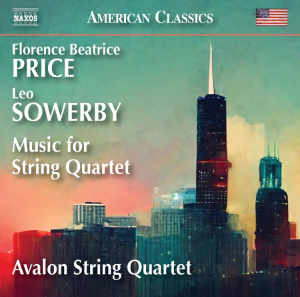
Florence Beatrice Price (1887-1953)
String Quartet No. 2 in A minor (1935)
Five Folksongs in Counterpoint for String Quartet (1951)
Leo Sowerby (1895-1968)
String Quartet in G minor, H. 226 (1935)
Avalon String Quartet
rec. 2022, Boutell Memorial Concert Hall, Northern Illinois University, USA
Naxos 8.559941 [74]
A further installment in the series of Naxos American Classics, this disc represents a fine contribution to the ever-growing discography of Florence Price. However, it is not the only CD to contain her music for string quartet. A two-disc set presumably of all her chamber music for strings performed by the Catalyst Quartet (with Michelle Cann in the piano quintets) on Azica received very positive reviews. I have not heard that, but find her pieces here attractive. Price composed her String Quartet No. 2 in 1935, but it was not discovered until 2009, among other major compositions in an abandoned summer home in Illinois, and published only in 2019.
The quartet is in four movements with the third a juba instead of the traditional scherzo, something also found in Price’s symphonies. While the quartet reveals shades of Borodin and Dvořák, it likewise possesses an American folk flavour with a touch of blues. The work is well constructed with memorable tunes, and the Avalon String Quartet produces a vibrant, but warm account. The recording itself is quite close with real presence. The first movement, marked Moderato is twice the length of each of the other movements with its development based on the second theme of the movement. It concludes vivaciously. The ensuing Andante cantabile, begins with a Dvořák-like song in the style of a spiritual. I can’t help but thinking that the Czech’s American Quartet (No. 14) must have influenced Price. This beautiful movement is followed by the aforementioned Juba, a native slave-era dance, that is vigorous and syncopated—quite jazzy. The second section is also dance-like, but with a different rhythm and is really catchy before the juba returns. The finale also has jig-style rhythm, but is more complex than the preceding movement. It is a typical rondo for the most part with slower, contrasting passages and a pensive theme. The music accelerates greatly before concluding on a forceful, minor chord. I was quite impressed with the work, as I was with the performance here.
The disc ends with one of two series of folksongs that Price arranged and elaborated on for string quartet. The earlier set from around 1947 is titled Negro Folksongs in Counterpoint and is in four movements. This one is in five and each of these is based on a popular melody. The first is on the spiritual Calvary and contains much counterpoint. The following alludes to the California Gold Rush and is based on Clementine, which provides a welcome contrast. Her treatment of the tune reminded me of something Charles Ives might have done, first with the tune played simply and then more elaborately with changes in harmony. The third movement, taking Drink to Me Only with Thine Eyes as its theme, is beautifully lyrical before moving in harmonically unrelated keys and employing whole tones here and there. This is followed by another juba-style movement based on the light, rhythmic, and catchy African American Shortnin’ Bread. The set finishes with the spiritual Swing Low, Sweet Chariot, introduced by solo cello and containing much variety in its thematic treatment. It closes assertively on a C major unison chord. The Five Folksongs in Counterpoint constitutes a good introduction to Florence Price’s chamber music with its familiar melodies treated with variety and some complexity.
In between the Price pieces is Leo Sowerby’s second string quartet, the Quartet in G minor. It may seem like an odd bedfellow in the context of the programme, but its inclusion is justified since Sowerby was also a midwestern American composer whose quartet, which remains unpublished, was written in the same year as Price’s. That said, its dissonance and comparative darkness has little of the melodic allure of Price’s music. Sowerby, a prolific composer, was best known for his organ and sacred choral works that sometimes crop up in religious services. I remember hearing these when I was growing up in the 1950s and 60s and finding them rather dour and unattractive. His four-movement quartet here left a different impression from Price’s on me. I found it overall harder to like, not forbidding, by any means, but not really memorable for the most part. It is well constructed with a second movement scherzo, marked Very fast reminiscent of Hindemith its irregular rhythms and syncopation. The slow movement, however, begins with a beautiful cello solo that is quite sad and lonely. The cello plays a major role here and returns as soloist with the other strings accompanying. The finale returns to dissonance and even despair before a somewhat academic fugue takes charge until the work ends incongruously on a major chord. The Avalon musicians seem to have the measure of the music, even if it is not something I will likely listen to again soon.
For those interested in Price’s chamber works, I would seek out the Catalyst discs for a more complete picture of her oeuvre. The Naxos CD, though, provides plenty of pleasure in the two pieces presented, especially in such splendid performances as these by the Avalon String Quartet. The Sowerby quartet is more of an acquired taste. Naxos’s recording is first-rate, as are the notes on the works by Brian Hart, Professor of Music History at Northern Illinois University.
Leslie Wright
If you purchase this recording using a link below, it generates revenue for MWI and helps us maintain free access to the site




















